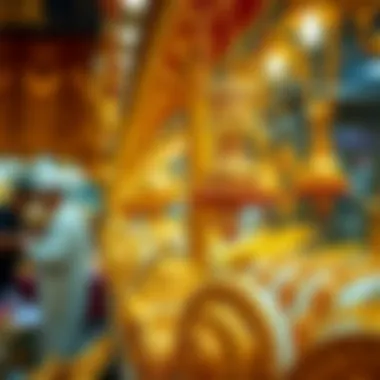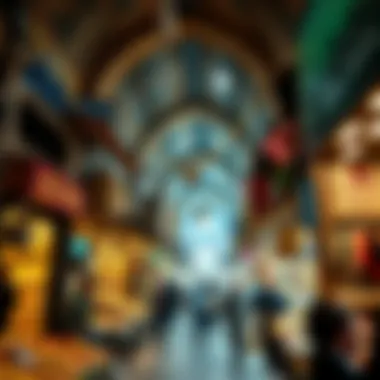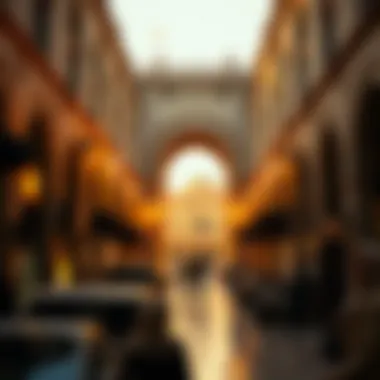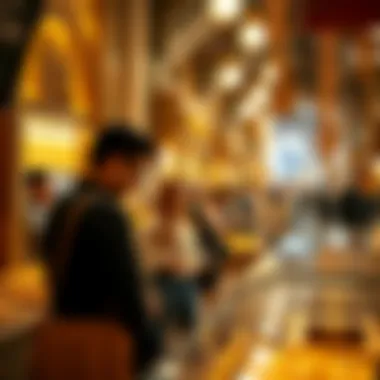The Gold Souk's Transformation: Dubai's Trade Epicenter


Intro
The Gold Souk in Dubai is not just a market; it’s a vibrant tapestry woven with threads of culture, history, and commerce. This bustling hub has morphed over decades, reflecting not only changes in trade practices but also the dynamic essence of Dubai as a global trading metropolis. Nestled in the heart of the city, the Gold Souk serves as a magnet for tourists and locals alike, drawing them into its glittering embrace of gold, jewels, and intricate craftsmanship.
Dubai's Gold Souk stands as a testament to the city’s values and heritage. It provides a lens through which we can explore the historical significance of gold trade in the region. From ancient caravan routes to modern retail outlets, the evolution of this marketplace is marked by remarkable transformations and adaptations to shifting economic landscapes.
As you stroll through its narrow alleyways, you see the delicate balance between tradition and modernity. Stunning displays of gold ornaments, intricate designs, and the humble yet persistent call of merchants beckoning buyers alike. Understanding the evolution of the Gold Souk provides valuable insights into both the cultural fabric and economic backbone of Dubai.
This article will delve into various facets of the Gold Souk, examining its historical roots, cultural implications, and its current role in shaping the local economy amid global trends. We will highlight market trends within the real estate sector that surround the Souk, offering clarity for investors, homebuyers, and analysts interested in this unique geographical and economic context.
Let’s begin our exploration by discussing the current market trends that frame the Gold Souk and its surrounding properties.
Intro to the Gold Souk
The Gold Souk in Dubai is often perceived as a mere collection of shops that glisten under the warm Arabian sun. However, this bustling market serves a far greater purpose than just a display of shiny items for sale. The Gold Souk is not only a global nexus for gold trade but also a rich tapestry of history, culture, and economic significance that reflects both the past and future of Dubai. Understanding the Gold Souk involves examining its multifaceted layers that contribute to Dubai’s identity as a trading powerhouse in the Middle East.
Historical Context
The roots of the Gold Souk stretch back many decades, tracing a path of trade that goes beyond the glitter of gold itself. Back in the 1940s, Dubai was evolving from a modest fishing village to a burgeoning trade center. Local merchants began trading gold, and as demand surged, the Gold Souk blossomed into an iconic marketplace. People flowed from various regions, eager to purchase jewelry that often marked significant life events, such as weddings or family gatherings.
The influence of diverse cultures is palpable here, with shops often adorned with various styles of craftsmanship. Visitors can encounter traditional Arabic designs as well as contemporary aesthetics, a nod to the city’s evolving identity as a global destination.
"The Gold Souk stands as a testament to Dubai's trade legacy, where centuries-old traditions intertwine with modern commercial practices."
Location and Layout
Nestled in the heart of Deira, the Gold Souk is easily accessible, serving as a significant landmark in Dubai's vibrant landscape. The market is characterized by narrow alleys filled with shopfronts that showcase a spectrum of gold jewelry—ranging from intricate bridal sets to simple gold chains. Walking through the souk, one encounters the delightful clamor of vendors bargaining with customers, the rich scents of spiced Arabic coffee wafting through the air, and patrons admiring the brilliance of gold that varies in purity and craftsmanship.
The layout of the Gold Souk is far from random; it is cleverly designed to enhance the shopping experience, with shops artfully arranged to entice foot traffic. This bustling marketplace comprises over 300 retailers, each one contributing its flair to the overall atmosphere. A leisurely stroll through the souk reveals not only gold but also a variety of other precious stones, including diamonds, rubies, and emeralds, which together create a captivating display.
Cultural Significance
The Gold Souk stands as a testament to Dubai's identity, reflecting a rich tapestry of cultural heritage intertwined with the rapid evolution of modern trade practices. It is not merely a marketplace; rather, it embodies centuries of tradition, craftsmanship, and a deep-rooted connection to the community. The significance of the Gold Souk goes beyond its role in commerce; it shapes the cultural and social landscape of Dubai in various ways.
Traditions and Practices
Within the confines of the Gold Souk, age-old traditions flourish alongside contemporary trends. The souk is not just a place to buy gold; it's a vibrant hub where locals share stories and pass down knowledge about gold trading, jewelry making, and the artistry involved.
For many families, visiting the Gold Souk is a rite of passage, often associated with significant life events—be it a wedding or the birth of a child. Many believe that buying gold during these occasions brings good luck and prosperity. The rich variety of jewelry styles reflects the diverse influences on Dubai's culture, from Islamic motifs to modern designs.
Moreover, the bargaining culture prevalent in the Gold Souk not only enhances the shopping experience but also fosters camaraderie among buyers and sellers. Locals often engage in playful negotiation, transforming what could be a mere transaction into an experience steeped in joy. Understanding the local customs can make all the difference; for instance, casually chatting with vendors or respectfully asking questions about their craft showcases appreciation for their hard work.
A Hub for Tourists
The allure of the Gold Souk is undeniable. Tourists flock here in droves to immerse themselves in the mesmerizing sight of gold in all its forms. This bustling hub isn’t just for the curious traveler; it’s a place where cultures collide, creating a unique experience infused with local flavors.
Notably, it serves as a cultural bridge where visitors can witness the traditional craftsmanship up close. Many shops display artisans at work, meticulously crafting exquisite pieces. Keeping a keen eye on these processes not only offers a behind-the-scenes look but also adds a personal touch to a purchase, making it infinitely more valuable.
- Visitors often rave about:
- The vibrant atmosphere brimming with life and interaction
- The impressive selections of jewelry—from intricate bracelets to delicate necklaces
- The chance to understand the heritage of gold trading and its significance in Emirati culture
Additionally, the Gold Souk's location adds to its appeal, nestled close to other attractions such as the Dubai Creek and historical neighborhoods. The market effortlessly combines a sense of nostalgia with the modernity of Dubai, making it a vital part of any tourist's itinerary. The unique experience of shopping here often results in lasting memories and cherished pieces that tell a story.
Economic Impact


The economic vitality of the Gold Souk is hard to underestimate. This bustling marketplace doesn't just serve as a shining example of Dubai's rich trading history; it plays a pivotal role in the locale's ongoing economic growth. With increasing globalization and the rise of e-commerce, the Gold Souk has had to adapt. Its influence stretches out beyond the market itself—shaping trade practices, boosting tourism, and even providing local job opportunities.
Contribution to Dubai's Economy
The Gold Souk contributes significantly to Dubai's economy in a few key ways:
- Tourism Magnet: Drawing millions of tourists annually, the Souk acts like a beacon for those eager to purchase gold and jewelry. Tourists often allocate a good chunk of their budget to take back a taste of luxury. Not just the Souk itself, but businesses surrounding it, such as hotels and eateries, also see a boost.
- Direct Trade Revenue: Gold is a high-value commodity, and its trade generates substantial income for local businesses and the government. The customs and taxes collected on gold sales bring in a noteworthy revenue stream that bolsters the public purse.
- Cultural Heritage: The Gold Souk is not merely a shopping destination. It's a cultural hub that highlights Dubai’s legacy in trade. As a result, it enhances the city’s global image, making it a place where business meets tradition, thus attracting more investment.
- Market Diversification: Dubai has long been painted as a serious player in the global trade arena. The Gold Souk reinforces this narrative, attracting interests beyond just gold. The marketplace also serves as a backdrop for initiatives meant to diversify Dubai's economy.
"The Gold Souk serves not just as a marketplace, but as a cultural and economic cornerstone that reflects Dubai’s ability to adapt and thrive."
Employment Opportunities in the Gold Souk
Beyond economic contributions, the Gold Souk creates numerous jobs, direct and indirect, which is a major factor in Dubai's rapidly advancing economy. Here’s how:
- Direct Employment: The souk is home to hundreds of retailers, crafting countless jobs in different sectors. Jewelers, shopkeepers, artisans, and their staff all play a part in keeping this vibrant market alive.
- Skills Development: Those working in the Gold Souk often acquire valuable skills such as craftsmanship and customer service. This acquired know-how can be transferable, opening up career paths elsewhere.
- Supporting Industries: The scope of employment extends beyond just the Souk itself. Think of the packaging firms, logistics providers, or even those in banking services that cater specifically to gold traders. Each adds another layer of job creation tied to the Gold Souk.
- Economic Resilience: In times of economic downturn, the souk often provides job stability for locals. People turn to the trade of precious metals as a reliable income source during rough patches.
The Gold Souk stands not just as a gleaming hub of commerce but as a crucial player in sustaining the local economy, adding depth to Dubai's trading landscape.
Gold Souk's Offerings
The Gold Souk is not merely a marketplace; it represents a living tapestry of culture, tradition, and economic viability. With its vibrant atmosphere filled with the glimmer of gold, the souk offers a unique blend of products and services that cater to a diverse clientele. For investors and homebuyers eyeing opportunities in Dubai's burgeoning market, an understanding of what the Gold Souk has to offer is crucial. This section will delve into the specific types of gold available and the customization options that enhance the shopping experience.
Types of Gold Available
Gold is available in a variety of forms within the souk, each with its own distinct characteristics and appeal. The most common type is 24-karat gold, known for its purity, which comes in both jewelry and bullion forms. This high-purity gold often serves as an investment, reflecting a strong cultural preference in many Middle Eastern countries.
However, it is not just the pureness of gold that attracts customers; the designs and styles also play a significant role. The Gold Souk is famous for its 22-karat gold items which blend durability and beauty. Another popular option includes 18-karat gold, which offers a mix of metallic strength and affordability, making it appealing for everyday wear.
- Gold Bullion Bars – An investment product, often sought after by those looking to invest in physical gold.
- Gold Coins – Various coins, including seasonal designs, are available, appealing to collectors.
- Designer Jewelry – Pieces crafted by skilled artisans that showcase exquisite detail and unique designs.
Each type comes with its own pricing structure, influenced by current market trends and global economic factors.
Jewelry and Customization
A pivotal feature of the Gold Souk is its extensive range of customization options. Customers can tailor everything from simple rings to elaborate necklaces, reflecting personal style while also adhering to cultural significance. Jewelers are often willing to take on commission work, allowing buyers to engage in the creation process. This craft-based approach fosters a deeper connection between the jewelry and its owner.
When purchasing jewelry, understanding local traditions can also enrich the experience. For example, during certain festivals, people often choose to customize their pieces to celebrate rather than purchase ready-made items. Some common customization options include:
- Engraving: Adding initials or special dates to personalize a piece.
- Stone Inlays: Many jewelers offer options to embed precious stones like diamonds or sapphires, enhancing the aesthetic appeal.
- Design Modifications: Clients can alter existing designs to better fit their vision, whether modifying a bracelet length or changing a chain style.
By nurturing a relationship with local artisans, buyers not only secure unique pieces but also contribute to Dubai’s rich craft heritage. The Gold Souk thus stands as a significant player in the cultural landscape, reinforcing its symbolic essence as much more than a marketplace.
Navigating the Market
In today’s complex economy, understanding how to navigate the Gold Souk is essential for potential investors and buyers alike. The Gold Souk is not just a marketplace; it is an experience steeped in history and culture, giving life to the trade of gold in Dubai. As such, one must grasp various elements when entering this vibrant marketplace. This section will delve into the nuances of pricing structures and offer insightful bargaining tips to help customers make well-informed purchases.
Pricing Structures
Gold pricing in the Souk is not as straightforward as it seems. Typically, the price of gold fluctuates based on global market rates influenced by several factors, including:
- Market Demand: When global demand is high, prices tend to soar. Conversely, during economic downturns, the prices might dip.
- Purity Levels: Gold is measured in karats, with 24-karat gold being the purest. The higher the karat, the more you’ll pay. Buyers should be aware of the purity to avoid overpaying.
- Craftsmanship and Design: The artistry involved in creating jewelry can also affect pricing. Intricate designs or artisan-crafted pieces may carry a premium, reflecting the skill of the maker.
While shopping, it’s common to see prices listed in terms of grams, which introduces a bit of math into the equation. Shoppers must also consider additional costs like taxes or commissions, which can add to the final price. As such, becoming savvy about these factors can aid one in making a fair purchase without falling into traps that might lead to regret.
Bargaining Tips for Buyers


Bargaining is not just a practice; it's part of the culture in the Gold Souk. One must keep in mind that the initial price is often just a starting point. Here are some strategic tips to consider when negotiating:
- Do Your Homework: Understanding current gold rates and market trends is crucial. Keep an eye on daily rates online before entering the Souk, enabling you to call the shots during negotiations.
- Be Polite but Firm: Negotiation is an art that requires courtesy. A friendly demeanor can go a long way in winning over sellers. However, maintain firmness to ensure you aren’t pushed into a deal that doesn’t suit you.
- Start Low: When making an offer, begin with a price lower than the asking one. This sets a base for negotiations and allows room for necessary increments.
- Walk Away if Needed: Indicating that you might step away can sometimes lead sellers to lower their prices in an attempt to keep you in the store. It conveys to them that there are options and that you’re not desperate.
Building rapport with the shopkeepers enriches your experience, and may lead to better deals. Every shop has its own character, and a good relationship can often translate into better prices.
By employing these strategies, buyers can enhance their experience in the Gold Souk while maximizing their investments. With a combination of understanding pricing structures and effective bargaining skills, shoppers can navigate this traditional marketplace with confidence and insight.
E-commerce and the Gold Souk
The intersection of e-commerce and the Gold Souk marks a significant evolution in the way gold is traded and perceived in Dubai. The traditional Gold Souk, renowned for its exquisite jewelry and vibrant atmosphere, is now embracing the digital age, providing a fresh platform for buyers and sellers alike. The growing importance of this topic cannot be overstated as it reflects broader changes in consumer behavior and market dynamics within Dubai’s jewelry sector.
Emergence of Online Gold Trading
With the rise of e-commerce, online gold trading has become a viable alternative to visiting physical marketplaces. Platforms like Fanchu and GoldStack allow consumers to buy gold directly from their phones or laptops, bypassing the need for in-person transactions.
This shift has been driven by several key factors:
- Convenience: Shoppers can compare prices easily from the comfort of their homes. No more haggling in crowded souks.
- Price Transparency: Online platforms often showcase live market rates, helping buyers make informed decisions.
- Broader Accessibility: International customers can purchase Dubai's renowned gold items, expanding the market reach for local traders.
It’s important to note that the emergence of online gold trading does not mean the end of traditional shopping experiences. In fact, these digital platforms enhance the market by providing options that cater to the changing preferences of consumers.
Impact on Traditional Retail
The advent of e-commerce has undeniably affected conventional retail within the Gold Souk. While foot traffic to the souk may fluctuate, it's clear that the online market is reshaping how sellers operate.
For instance:
- Store Adaptation: Many jewelers are enhancing their online presence, integrating both physical and digital sales strategies. Having a strong showroom is no longer sufficient; online portfolios are essential.
- Customer Engagement: Retailers utilize social media and websites to engage with customers, showcasing new designs and promotions to keep the clientele interested.
- Sales Competition: Shops might find it challenging to compete with online prices, leading to an important consideration about maintaining competitive pricing strategies while still delivering the beauty and craftsmanship associated with their pieces.
The reality is this digital transformation has birthed a new generation of traders who are well-versed in e-commerce, pushing the established merchants to rethink their strategies. The traditional Gold Souk must adapt or risk being a relic of the past, full of beautiful artifacts but perhaps outdated in practice.
Challenges Facing the Gold Souk
This section delves into the complications that the Gold Souk faces in today's rapidly changing marketplace. It isn't sunshine and rainbows; issues like global economic shifts and stringent regulations cast long shadows over this market. Understanding these challenges is key for stakeholders who want to keep their fingers on the pulse of Dubai's trading heart.
Global Economic Influences
One cannot underestimate the magnitude of global economic conditions on the Gold Souk. As the world becomes more interconnected, local markets are influenced by international trends and events. Economic downturns in major economies such as the US or China often ripple across the globe, leading to fluctuations in gold prices. When gold prices skyrocket during times of uncertainty, such as conflicts or financial crises, demand can outstrip supply, creating a precarious situation for retailers.
Moreover, when stock markets falter, investors flock to gold as a safe haven. This can lead to increased traffic at the Souk, but the volatility can also deter buyers who may wish to wait for prices to stabilize. Here are some factors at play:
- Currency Fluctuations: The value of the US dollar impacts gold pricing, particularly since international trade often occurs in dollars.
- Import Tariffs and Duties: Changes in tariffs or trade policies can affect how easily retailers can acquire inventory.
- Global Supply Chain Issues: The current focus on sustainability and ethically sourced materials means gold sourcing is increasingly scrutinized, potentially complicating supply chains.
As a result, any savvy investor or buyer must keep an eye on the broader economic context to understand the Gold Souk’s dynamics better.
Regulatory Issues
Regulation doesn't generally spring to mind when you think of the Gold Souk, but it's an overarching challenge. As governments across the globe crack down on illicit trade and money laundering, the regulations surrounding gold trading become more stringent. This creates a tough balancing act for retailers wishing to stay compliant while remaining competitive.
In Dubai, various governmental bodies have laid down regulations to ensure transparency and protect both buyers and sellers. Some of the headaches include:
- Licensing Requirements: Every seller must have the proper licenses, which can be costly and time-consuming to acquire.
- Traceability Standards: More emphasis is being placed on confirming the ethical sourcing of gold, requiring extensive paperwork and due diligence that some small retailers may struggle with.
- Consumer Protection Laws: These laws dictate how prices are displayed and could lead to penalties if not adhered to, further complicating the market environment.
"The evolution of regulatory frameworks could either be a boon or a bane. For the Gold Souk, navigating these waters is more critical than ever."


In essence, stakeholders should stay ahead of these changes, adapt their business practices accordingly, and keep a lookout for new regulations that might crop up.
To further explore this topic, check out these resources:
- Wikipedia's take on Gold Markets
- British Council on Global Economic Trends
- Reddit discussions on Investment Strategies
Ultimately, while challenges persist, they also present opportunities for those willing to adapt and innovate.
Future Trends
As the Gold Souk continues to thrive amid changing market dynamics, understanding the future trends emerging in this iconic marketplace is essential. This section delves into two pivotal developments: the rise of sustainable practices in gold trading and the incorporation of technological innovations. Each of these aspects presents significant benefits and considerations for investors, homebuyers, agents, and analysts alike.
Sustainable Practices in Gold Trading
With increasing awareness of environmental issues, sustainable practices in gold trading have become imperative in the corporate landscape. Industries are under pressure to adopt methods that minimize ecological harm, and the gold trade is no exception.
- Ethical Sourcing: There's a noticeable shift towards sourcing gold from mines that adhere to strict environmental and labor standards. This not only results in more sustainable mining practices but also fosters trust among consumers who are increasingly discerning about the origins of the products they buy.
- Recycling Initiatives: A growing number of players in the gold market are embracing recycling to mitigate the demand for newly mined gold. This includes reclaiming gold from old jewelry, electronic waste, and other sources. Initiatives aimed at recycling kan help to fortify a circular economy, which resonates well with environmentally conscious buyers.
- Transparency: Companies that prioritize transparency regarding their supply chains can enhance their reputation among consumers. Engaging in environmentally friendly practices and making information available can give these businesses a competitive edge. Investing in sustainable businesses not only makes ethical sense but can also yield high returns as market trends shift.
The Souk Within the Real Estate Context
The intricate relationship between the Gold Souk and Dubai's real estate landscape cannot be overstated. Situated in the heart of the city, the Souk acts as a magnet, attracting not only shoppers but also investors and real estate developers alike. The importance of this dynamic is multifaceted, reflecting the area’s rich cultural tapestry and its economic stakes.
Real Estate Developments Near the Gold Souk
One cannot walk through the streets surrounding the Gold Souk without noticing the numerous construction projects and towering buildings that define the skyline. Over the past few years, several real estate developments have cropped up nearby, each designed to enhance accessibility and provide amenities to residents and tourists.
Key Developments:
- Deira Enrichment Project: This ambitious initiative aims to revitalize the historic district with modern residential and commercial spaces, all while maintaining the unique cultural charm of the area. Developers are keen to blend traditional architecture with modern designs.
- Dubai Creek Harbour: Just a short distance from the Gold Souk, this expansive waterfront development is set to become a key residential and tourist hub, promising stunning views and luxury living.
- Al Ghurair Centre: Established in the early days of Dubai’s commercial evolution, this mall offers a blend of shopping and entertainment options. Recent renovations promised to bring additional foot traffic to the area, critical for the Souk’s vendors.
The influx of modern developments near the Gold Souk has ignited a new wave of opportunities for both locals and foreigners. Developers are keenly aware that being close to such a vibrant trading hub not only boosts property values but also enhances rental yields.
Investment Opportunities Linked to the Souk
For savvy investors, the proximity to Dubai’s Gold Souk opens doors to various lucrative investment opportunities. Properties near the Souk are often seen as prime real estate, not just for residential buyers but also for commercial enterprises, able to cater to the flowing tourist traffic.
Potential Investment Avenues:
- Commercial Real Estate: Establishing businesses that cater to tourists and locals alike, including restaurants and retail spaces, can yield substantial returns. The buzzing atmosphere of the Souk means high customer turnover.
- Rental Properties: With the continuous influx of tourists, investing in short-term rental properties can be particularly profitable. Apartments located nearby can command premium prices, especially during peak tourist seasons.
- Mixed-Use Developments: Combining residential, commercial, and retail spaces under one roof can attract a varied demographic, ensuring constant flow and engagement. This approach creates a micro-economy where residents benefit from amenities like shops and cafes at their doorstep.
In essence, the Gold Souk acts as a pivotal landmark within Dubai’s real estate narrative. It not only attracts foot traffic but serves as a beacon for investors looking to capitalize on the area's unique cultural and economic attributes. As the real estate landscape continues to evolve, the importance of the Souk remains a constant, guiding the forces of development and investment in this thriving city.
Ending
In wrapping up our exploration of the Gold Souk, it’s clear that this vibrant marketplace is not just a gathering of shops; it is a testament to Dubai’s rich heritage and economic prowess. The Gold Souk serves as a symbol of trade and cultural exchange, blending the old with the new while adapting to modern demands. Understanding its significance is crucial for various stakeholders, notably investors, homebuyers, agents, and market analysts.
Summary of Insights
The Gold Souk has evolved throughout the years, reflecting shifts in consumer behavior and broader market trends. Its historical roots are deeply entwined with Dubai’s growth as a key trade hub in the Middle East. The local economy has benefited immensely from the Gold Souk, not just through direct sales but also via employment opportunities it generates, making it a cornerstone of livelihood for many residents. As highlighted in this article, the Gold Souk also plays a crucial role in attracting tourists, offering them an authentic glimpse into Dubai’s opulent lifestyle.
- Cultural Significance: It serves as a place where rich traditions are still on display, from the intricate designs of gold jewelry to the age-old practice of bargaining.
- Economic Impact: The marketplace impacts local economies through both retail and the wider hospitality sector.
- Emerging Challenges: The Gold Souk faces obstacles due to global market influences and regulatory hurdles, highlighting the need for resilience and adaptability.
Final Thoughts on the Gold Souk's Future
Looking ahead, the future of the Gold Souk appears promising yet challenging. With increasing competition from e-commerce platforms, traditional retailers must innovate or risk obsolescence. Sustainability also stands at the forefront of future practices, as consumers become more aware of ethical sourcing. The integration of technology could streamline both shopping experiences and operational efficiencies, bridging the gap between tradition and the digital age.
“The Gold Souk’s future will be defined by how it balances its rich heritage with the demands of modern consumers.”
Moreover, as real estate developments continue to rise in proximity to the Gold Souk, new investment opportunities are likely to emerge, enhancing the market’s allure for both local and foreign investors. By maintaining the character of the Gold Souk while embracing change, it can continue to thrive as a symbol of Dubai’s enduring legacy and ambition in the global marketplace.
As we contemplate the future of the Gold Souk, it is essential to recognize its role not only as a marketplace but as a cultural landmark that reflects the evolving identity of Dubai itself.











